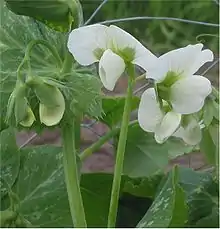Pisum
Pisum is a genus of the family Fabaceae, native to southwest Asia and northeast Africa. It contains one to five species, depending on taxonomic interpretation; the International Legume Database (ILDIS) accepts three species, one with two subspecies:[1]
- Pisum abyssinicum (syn. P. sativum subsp. abyssinicum)
- Pisum fulvum
- Pisum sativum - pea
- Pisum sativum subsp. elatius (syn. P. elatius, P. syriacum)
- Pisum sativum subsp. sativum
| Pisum | |
|---|---|
 | |
| Pisum sativum | |
| Scientific classification | |
| Kingdom: | Plantae |
| Clade: | Tracheophytes |
| Clade: | Angiosperms |
| Clade: | Eudicots |
| Clade: | Rosids |
| Order: | Fabales |
| Family: | Fabaceae |
| Subfamily: | Faboideae |
| Tribe: | Fabeae |
| Genus: | Pisum L. |
| Type species | |
| Pisum sativum L. | |
Pisum sativum (the field or garden pea) is a major human food crop (see Pea and Split pea).
Pisum species are used as food plants by the larvae of some Lepidoptera species including Bucculatrix pyrivorella, cabbage moth, common swift, ghost moth, Hypercompe indecisa, the nutmeg, setaceous Hebrew character and turnip moth.
The Pisum sativum flower has 5 sepals (fused), 5 petals, 10 stamens (9 fused in a staminal tube and 1 stamen is free) and 1 subsessil carpel.
References
- http://www.ildis.org/LegumeWeb/6.00/names/npall/npall_567.shtml
- Gledhill, David (2008). "The Names of Plants". Cambridge University Press. ISBN 9780521866453 (hardback), ISBN 9780521685535 (paperback). pp 304
This article is issued from Wikipedia. The text is licensed under Creative Commons - Attribution - Sharealike. Additional terms may apply for the media files.
